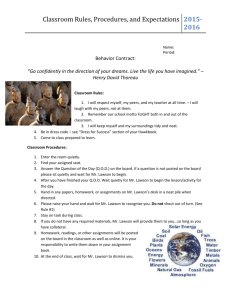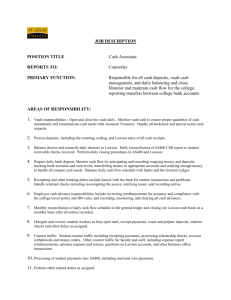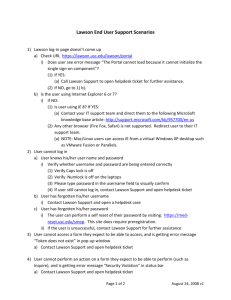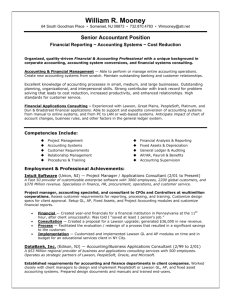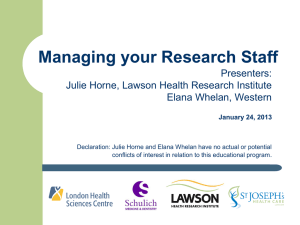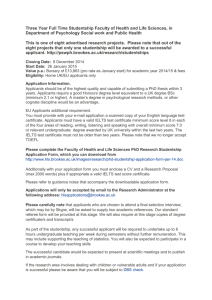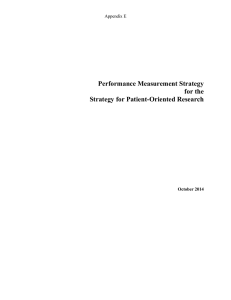July - London Health Sciences Centre
advertisement
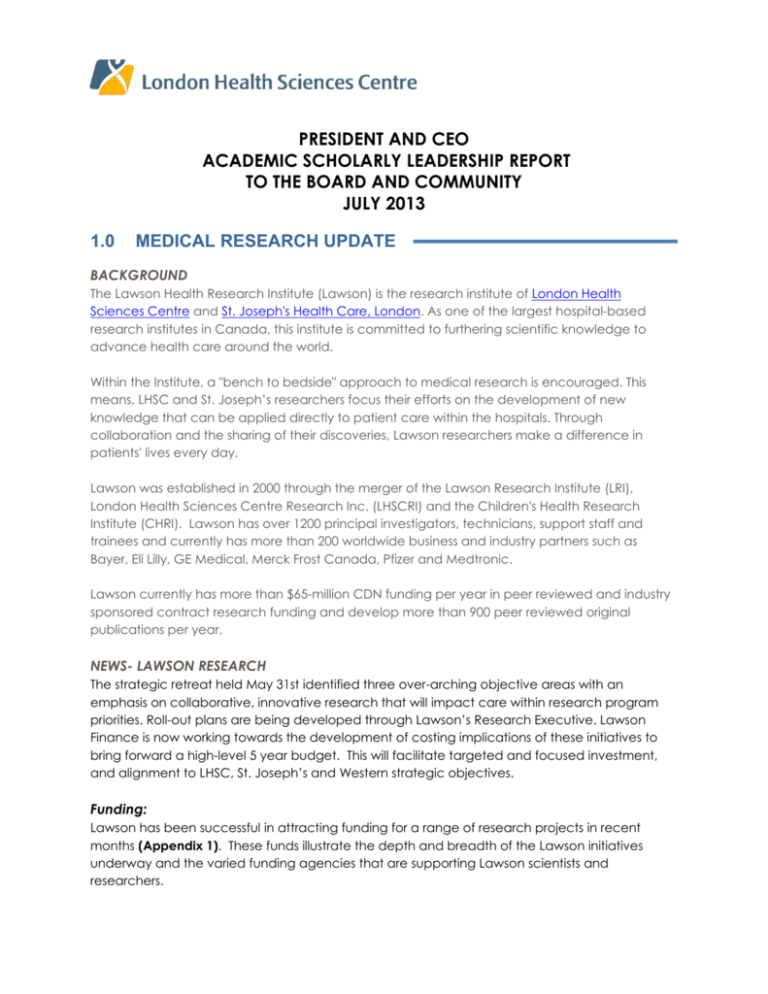
PRESIDENT AND CEO ACADEMIC SCHOLARLY LEADERSHIP REPORT TO THE BOARD AND COMMUNITY JULY 2013 1.0 MEDICAL RESEARCH UPDATE BACKGROUND The Lawson Health Research Institute (Lawson) is the research institute of London Health Sciences Centre and St. Joseph's Health Care, London. As one of the largest hospital-based research institutes in Canada, this institute is committed to furthering scientific knowledge to advance health care around the world. Within the Institute, a "bench to bedside" approach to medical research is encouraged. This means, LHSC and St. Joseph’s researchers focus their efforts on the development of new knowledge that can be applied directly to patient care within the hospitals. Through collaboration and the sharing of their discoveries, Lawson researchers make a difference in patients' lives every day. Lawson was established in 2000 through the merger of the Lawson Research Institute (LRI), London Health Sciences Centre Research Inc. (LHSCRI) and the Children's Health Research Institute (CHRI). Lawson has over 1200 principal investigators, technicians, support staff and trainees and currently has more than 200 worldwide business and industry partners such as Bayer, Eli Lilly, GE Medical, Merck Frost Canada, Pfizer and Medtronic. Lawson currently has more than $65-million CDN funding per year in peer reviewed and industry sponsored contract research funding and develop more than 900 peer reviewed original publications per year. NEWS- LAWSON RESEARCH The strategic retreat held May 31st identified three over-arching objective areas with an emphasis on collaborative, innovative research that will impact care within research program priorities. Roll-out plans are being developed through Lawson’s Research Executive. Lawson Finance is now working towards the development of costing implications of these initiatives to bring forward a high-level 5 year budget. This will facilitate targeted and focused investment, and alignment to LHSC, St. Joseph’s and Western strategic objectives. Funding: Lawson has been successful in attracting funding for a range of research projects in recent months (Appendix 1). These funds illustrate the depth and breadth of the Lawson initiatives underway and the varied funding agencies that are supporting Lawson scientists and researchers. Chief Executive Officer Report to the Board Page 2 External Initiatives: The Council of Academic Hospitals of Ontario (CAHO) has responded to the recent report of the Research Hospital Resourcing Task Force (Fuelling the Innovation Engine). The report highlighted that in the current fiscal climate, funding for health research is increasingly uncertain and complex. Hospital-based research entities are supporting a significant proportion of risk as a result of growing resource gaps and instability. To implement the recommendations outlined in their report, six task forces have been created: Research Hospital Resourcing Coordination Task Force Research Financials Task Force Resourcing Opportunities Task Force Infrastructure Collaborations Task Force Clinical Trials Task Force Research Metrics Task Force Lawson leaders are engaged in this work and will be key contributors in defining strategies to address the challenges presented. Canadian Institute of Health Research (CIHR) Strategy for Patient-Orientated Research (SPOR) is a collaboration network of patients, health professionals, decision makers, health researchers and their partners from across Canada. Their primary objective is to generate evidence and innovations that advance practice and policy changes leading to transformative and measureable improvements in patient health, health care and efficiency and effectiveness of service delivery. The focus of the Ontario SPOR Support Unit and funded activities are detailed in Appendix 2. LAWSON IN THE NEWS: Dr. Raymond Kao was the recipient of the first Chair in Military Critical Care Research in Canada, awarded in an open ceremony on January 31st. The Chair is named after Group Captain G. Edward Hall, known in London for his service as Western University’s Dean of Medicine and longest serving president. While Dr. Kao’s research findings have been used to help stabilize wounded soldiers in battle, it has also been of importance in operating rooms in Canada when dealing with traumatic injuries. Dr. Kao is the senior critical care advisor to the Surgeon General Brigadier-General of the Canadian Armed Forces, a critical care physician at LHSC and a Lawson researcher. Coverage: London Community News, Metro News, AM1290, Western News A study by Dr. Rita Suri shows more frequent dialysis may increase the risk of complications where the blood leaves and re-enters the body. Conventional dialysis is administered three times per week, but recently there has been a trend toward more frequent dialysis. While greater frequency can provide patients with improved health and quality of life, according to Dr. Suri, patients undergoing more frequent dialysis are 76% more likely to experience complications at the access site. The study is published in the Journal of the American Society of Nephrologists (JASN). Chief Executive Officer Report to the Board Page 3 Coverage: The London Free Press New research from Richard Kim shows the effects of a common breast cancer treatment can be reduced by as much as 30% during Canadian winters. The lack of vitamin D exposure over the cold months impacts the body’s ability to metabolize tamoxifen, the drug. The study, published in Breast Cancer Research and Treatment, suggests physicians should take a personalized approach to prescriptions to ensure patients receive the optimal dose of the drug. Media Coverage: CTV London, Metro News On April 25th, Cheryl Forchuk hosted the “Youth Matters in London Conference,” at Youth Opportunities Unlimited (YOU) downtown London. Now in its fourth year, the study is working to develop effective options in helping homeless youth by examining who chooses which treatment (housing first, treatment first, or simultaneous attention to both) and why, and then examining their outcomes. Attempts are being made to implement youth preference service selection and results are ongoing. Efforts are also being complimented by peer support programs, and a rent gift program supported by the Sisters of St. Joseph, which sends gifts of $50 to the landlords of the clients who are in the most desperate need of help. Coverage: CTV London Tecfidera is a new drug for patients with multiple sclerosis recently approved by Health Canada. The drug is showing promise for patients, helping to reduce relapses, reduce disease activities, and delay the progression of the disease. Marcelo Kremenchutzky, director of the Multiple Sclerosis Clinic, led the clinical trials for the drug in London and was featured in a news story on the drug on CTV London. COMMUNITY OUTREACH: Lawson recently hosted three Café Scientifiques, generously sponsored by CIHR (Canadian Institutes of Health Research): “Understanding Addictions” - On April 17th, Lawson investigators addressed addiction in today's society and the complex factors that influence this disease. The event – which sold out in just one week – was moderated by Dr. Cheryl Forchuk, and featured talks by Drs. Elizabeth Osuch and Rick Csiernik. “Chronic Diseases: Are they an effect of the environment or your genetic destiny?” On April 11th, Lawson researchers Cheril Clarson, Jason Gilliland, and David Hill discussed the complex interactions between genetics and environment that contribute to chronic diseases. The session was moderated by Victor Han. Lawson’s First Café Scientifique: High School Edition On February 26th, Lawson hosted the first ever Café Scientifique in a high school. The inaugural event, organized in conjunction with the Partners in Experiential Learning Program (PEL), was held at Mother Theresa Secondary School. Forty students from grade 9-12 attended, including PEL students placed in Lawson labs, co-operative education students, and others with an avid interested in pursuing science at the post-secondary level. The session was focused on cancer research. Jim Koropatnick and Harry Prapavessis spoke on factors impacting disease Chief Executive Officer Report to the Board Page 4 development, focusing on diet and exercise respectively. The event was very successful, with an active discussion period after the presentations. Stem Cell Public Forum: “Your Child’s Health: Do Stem Cells Really Offer a Miracle Cure?” On April 29th Children’s Health Research Institute (CHRI), Children’s Health Foundation (CHF), Lawson, and the Schulich School of Medicine & Dentistry hosted a public forum discussing, “Your Child’s Health: Do Stem Cells Really Offer a Miracle Cure?” This event featured talks by internationally renowned leaders in the fields of stem cell ethics and research. Following the forum, a panel of local stem cell researchers explored the success stories and potential limitations for the clinical application of stem cell research. Stem Cell Symposia: “Stem Cell Therapies: Ready for Prime Time?” Children's Health Research (CHRI), Children's Health Foundation (CHF), Lawson, and the Schulich School of Medicine & Dentistry hosted a half-day symposium on April 29th at Victoria Hospital. Entitled, “Stem Cell Therapies: Ready for Prime Time?” this event featured keynote presentations by internationally renowned leaders in the fields of stem cell clinical trials and ethics with local stem cell biologists. LAWSON RECOGNITIONS Please find attached in Appendix 3 some of the outstanding contributions of the Lawson researchers in their respective fields. WORLDiscoveries 2013 Annual Report, “The Edge Effect”, acknowledges the joint efforts of Lawson, Western and Robarts’ respective business development offices over the last 1 and 5 year periods. WORLDiscoveries (WD) is now one of the leading business development offices in Canada, routinely ranking in the top 5 nationwide across every material commercialization measure and annually generating one of the highest commercial returns per research dollar invested anywhere in the country. A number of Lawson researchers are featured in the report: o Dr. Chris Schlachta – WD helped develop the commercialization plan that turned Dr. Schlachta’s $3.2M 2012 ORF operating grant into $9.6M in funds from industry partners through to 2016. These funds will support his Research & Development and simulation-based training for laparoscopic and computer-assisted surgery at CSTAR. o Dr. Claire Temple – With WD and TechAlliance support, Dr. Temple and Colin Henderson have developed a kit to do fast frozen sections for use in MOHS micrographic surgery to effectively cure basal cell skin cancer. Their apparatus, known as a CryoCaddy, significantly reduces lab time and produces fast frozen sections with unprecedented accuracy. CryoCaddy can cut operating room times by 22%, a significant cost and resource savings. o Dr. Femida Gwadry-Sridhar – has worked with WD and TechAlliance since 2010 to commercialize Pulse InfoFrame, Inc., a spin-off company in the business of developing private health care analytics. Pulse InfoFrame offers a secure, web-based, database-driven clinical management platform that provides data management and integration systems targeted to the unique data requirements of medical specialist. o Dr. Ting Lee – continues to develop new imaging applications in perfusion and CT scanning. A Lawson and Robarts scientist, Dr. Lee is leading a multi-site Phase IIII clinical research study that compares the standard Chief Executive Officer Report to the Board 2.0 Page 5 NURSING & ALLIED HEALTH PROFESSIONAL SCHOLARLY PRACTICE SUMMARY OF ACADEMIC ACCOMPLISHMENTS APRIL 2012 – MAY 2013 As an academic health sciences centre, LHSC has three related missions including: Providing patients with timely access to advanced care, Educating and training the next generation of health care professionals, and Conducting leading-edge research and making it available to clinicians, administrators, policy makers and the public. Academic/Scholarly leadership in which the integration of patient care, education, and research uniquely defines LHSC and differentiates it from other health care organizations, enables access to world-class care, well-educated health care professionals, and state-of-theart research. This mandate positions LHSC as an innovation engine capable of accelerating the translation of new knowledge into leading practices. The integration of education, research and patient care at LHSC provides an enriching environment where students can learn and apply knowledge from the classroom to the bedside. Supporting the academic mission of LHSC through Nursing and Allied Health Professional Scholarly Practice initiatives is critical to ensuring that access to a range of specialized health services, education for the next generation of health providers, and generation and dissemination of new scientific knowledge and innovation is sustained. Linked below is a comprehensive inventory of academic accomplishments through the Nursing and Allied Health Professional Scholarly Practice portfolio which contribute to the academic mission of LHSC and improve patient care. A summary chart of activity is provided below. Publications Research In Progress Presentations Education Summary of Academic Accomplishments April 2012 – May 2013 31 (peer & editorial reviewed journals) 44 (projects) 86 (regional, provincial & international) 89 (internal & external initiatives) To read the detail for the academic accomplishments please click (here) for Appendix 4. Chief Executive Officer Report to the Board Page 6 3.0 HEALTHCARE REGIONAL NEWS Council of Academic Hospitals of Ontario (CAHO) Annual Report The Council of Academic Hospitals of Ontario (CAHO) is the non-profit association of Ontario’s 24 academic hospitals and their research institutes. CAHO provides a focal point for strategic initiatives on behalf of their member hospitals of which LHSC is a member. Please find below the link to the 2012/13 Annual Report. http://www.caho-hospitals.com/wp-content/uploads/2013/06/CAH-103-AR2013_Web.pdf Respectfully submitted, Bonnie Adamson APPENDIX 1-- FUNDING – Lawson and three partner organizations have been awarded $7 million to support production of non-reactor based medical imaging isotopes. The project is funded by Natural Resources Canada (NRCan) through the Isotope Technology Acceleration Program (ITAP). Michael Kovacs, Director of the Lawson Cyclotron & PET Radiochemistry Facility, will lead the project on behalf of Lawson. Michael Borrie was awarded $97,932 from the St. Joseph’s Health Care Foundation – Fiona Monckton Fund in support of Lewy Body Disease and Dementia Research. This funding will support his project entitled, “Lewy body spectrum disorders: A pharmacogenomics study of cholinesterase inhibitors investigating cognitive benefit, motor worsening, and brain imaging.” Robert Teasell has received $190,000 from Alternate Funding Plan Southwestern Ontario for his project entitled, “AFT Innovation Proposal: Rehabilitation Knowledge to Action Project (REKAP) 2 in Neurorehabilitation.” Lisa Van Bussel has received $50,000 from the Academic Medical Organization of Southwestern Ontario (AMOSO) AFP AHSC Innovation Grant for her project entitled, “Evaluation of an automated fall detection and monitoring system.” Canada Foundation for Innovation’s Leading Edge Fund and New Initiatives Fund recently awarded London researchers with over $7M in funding. Two Lawson investigators were successful: • Dr. Ting Yim-Lee received $961,524 to develop low x-ray dose CT scanning methods for studying the vascular system. The technology could lead to better treatments for cardiovascular disease and cancer. • Dr. Blain Chronik’s team received $705,911 to establish a comprehensive testing and development facility that supports industry and academic efforts to develop medical devices and technologies (pacemakers, vascular stents, artificial joints) compatible with MRI systems. Cheryl Forchuk received $70,290 from Human Resources and Skills Development Canada (HRSDC) for her project entitled, “An assessment and evaluation of London CAReS: Facilitating service through collaborative best practices.” This funding will support research into a new strategy for managing those members of the London community experiencing the complex, often interrelated, issues of homelessness, mental illness, addiction, and poverty. A team of London-based researchers, including Drs. Ian Chin-Yee, Cyrus Hsia, and Anargyros Xenocostas, have been awarded a $200,000 Innovation Grant from the Canadian Cancer Society. This grant will allow them to develop a specialized tool — a small gold-plated chip layered with sensors — that will be able to detect the activity of cell molecules called protein kinases that are often involved in cancer growth. Seven Lawson Scientists have received funding from the Canadian Institutes of Health Research (CIHR): • Dr. Frank Beier has received $742,325 over 5 years for his project entitled, “Rac1 in skeletal development and homeostasis” • Dr. Dean Betts has received $100,000 over 1 year for his project entitled, “Extra-telomeric functions of telomerase reverse transcriptase (TERT) isoforms” • Dr. Elizabeth Finger has received $293,408 over 4 years for her project entitled, “The impact of emotional mimicry and oxytocin on frontotemporal dementia” • Dr. Amit Garg has received $352,097 over 6 years for his project entitledt, “Safety and Outcomes of Accepting Hypertensive Individuals as Living Kidney Donors.” • Dr. David Holdsworth has received $649,806 over 5 years for his project entitled, “Real-time microscopy during high-frequency mechanostimulation of living cells” • Dr. Wei-Ping Min has received $313,349 over 3 years for his project entitled, “The role of IDO1 vs IDO2 on tumour immune evasion and immune therapy” • Dr. Shawn Whitehead has received $598,500 over 5 years for his projected entitled, “Post-Stroke Brain Deterioration: Role of Abeta and Neuroinflammation” Jim Koropatnick received $55,095 from Ontario Centres of Excellence for his project entitled, "In Vivo Testing of Novel Anti-Cancer Therapeutics." Anthony Nichols received $222,700 over three years from the Canadian Cancer Society Quality of Life fall competition for his project entitled: “A Phase II randomized trial examining quality of life following treatment for early-stage squamous cell carcinoma of the oropharynx: radiotherapy vs. trans-oral robotic surgery (ORATOR)”. Dr. Chris Pin – is the recipient of an NSERC RTI Grant in the 2013-14 competition for his proposal entitled “High Resolution Imaging Suite for Analysis of Development”. The award is for $98,956. Sanjay Mehta has received $363,752 over three years from the Heart and Stroke Foundation for his project, “Mechanisms of Microvascular Endothelial Cell Apoptosis in Sepsis.” Overview of The Canadian Strategy on Patient Oriented Research (SPOR) Appendix 2 4 5 Ontario SPOR SUPPORT Unit Vision: The Ontario SPOR SUPPORT Unit will link up research and implementation strengths across province to produce positive impacts for patients, researchers, policy makers, health system administrators, firms and health care providers within a five year time frame. The province has an investment strategy for SPOR SUPPORT funds that will bring together and build on key strengths in order to: 1. Address key challenges that adversely affect patient care, in particular bridging between the silos in the Ontario health system 2. Foster high quality research that addresses the priority health needs of patients in Ontario 3. Identify and address the population health aspects of problems that are usually seen primarily in clinical terms, e.g., through large intervention studies designed to change practice and promote health behaviours 4. Enhance research by exploiting the globally recognized linked health data platform at ICES and making provincial data sets, and the capacity to use them, available to all clinical health service and population health researchers in Ontario and, in some cases, nationally (e.g., through SPOR Networks). Funded Activities: – Services and resources to enhance and support high quality high impact patient‐oriented research and implementation across the province – One time funding for select initiatives that are well poised to be implemented with positive results for patients (Ontario Stroke Network‐led demonstration project for first 2.5 years, next demonstration project(s) selected through collaborative governance structure). 6 7 Elements of the Ontario SPOR SUPPORT Unit† Consultation/ Rsrch Services Capacity Building Real World Clinical Trials KT & Implementati on Main SPOR SUPPORT Core Function(s) Methods Support & Development SPOR SUPPORT Contributions Data platform & Services Organization/Centre/ Team Coordinating Centre (TBD) One window for researchers, policy makers, patients, funders, and providers to access SPOR supports and services, reporting on SPOR SUPPORT unit performance measures, Chair operational management meetings, cross-UNIT coordination ICES Data Platform and Services (D. Henry) Expanded and enhanced data platform, new data services division Clinical Trials Ontario (S. Marlin) Streamlined approach to multi-centre clinical trials in Ontario Ontario Brain Institute (D. Stuss) Brain-CODE database, KTE and patient engagement in brain research Ottawa Methods Centre (J. Grimshaw and D. Fergusson) Methodological services and methods development Women’s Health KTE (P. Rochon) Women’s health knowledge translation and exchange and community-based women’s health research Y Y Y Primary Care Network (M. Stewart) Primary care reform with an emphasis on integration/coordination of care Y* Y Y* Health System Performance Research Network (W. Wodchis) Measurement and analysis to identify better ways to organize and manage the health system Y* Y Y* Drug Policy and Research Network (M. Mamdani) Independent scientific evidence and analyses to support drug policy Y* Y Y* Evidence and Values (J. Lavis and J. Hurley) Economic and policy analysis of health system performance, methods and tools for integrating evidence and values into decision-making Y* Y Y* Population Health Research Institute (In discussion) Child Health SUPPORT (M. Osmond and C. Macarthur) Integrated paediatric research supports including biostatistical design and analysis, and clinical research facilitation/education Demonstration Project Stroke improvement initiatives and data linking/analysis to achieve provincial targets for access to care and hospitalization rates †See Appendix for more detail on each element and the impacts under SPOR Y Y Y Y* Y Y Y Y Y* Y Y Y Y Y Y Y Y Y Y Y Y Y 8 Figure 2: Ontario SPOR SUPPORT Unit Coordination and Governance Note: will discuss with CIHR best opportunity to integrate CIHR representation Steering Committee Chair identified from within members including, for example, MOHLTC, MRI, CC Lead, CAHO, COU, Patient Representative(s), Provider Representative(s), Industry Representative(s), others Scientific Operational Management Team Advisory Committee Chaired by Lead for Coordinating Centre (CC), representatives from each of the 11 other groups plus the MOHLTC, MRI, and the demonstration project lead Chair identified from within members including, for example, HQO, PHO, IDEAS, COFM, IHPME, OICR, Patient Advocacy/Safety, Disease Charities, Industry, others Twelve Elements of OSSU CC Demonstration Project(s) Working Groups (e.g., on capacity building to support transformation) APPENDIX 3—LAWSON RECOGNITIONS– Dr. Paul Adams has been nominated for Fellowship through the Distinction of the Royal College of Physicians of Ireland. Admission to Honorary Fellowship is the highest honour the College can bestow. This honour is reserved for world leaders in medical science and exceptional contributors to the welfare of our communities both nationally and internationally. These nominees are distinguished in their field and value an association with the College. Dr. Vladimir Hachinski has received the Order of Ontario, the provinces’ highest honour. Dr. Hachinski is a world-renowned neurologist and one of the foremost authorities in the field of stroke and dementia and Alzheimer research. His discoveries have changed thinking, approaches and treatments to the benefit of millions. The appointees to the Order of Ontario were chosen for their contributions to the arts, law, science, medicine, history, politics, philanthropy and the environment. Queen Elizabeth II Diamond Jubilee Medals awarded The following Lawson Scientists will receive the Queen Elizabeth II Diamond Jubilee Medals: • Dr. William Clark • Dr. Vladimir Hachinski • Dr. Mary Jenkins • Dr. Mandor Jog • Dr. Raymond Kao • Dr. Vivian McAlister The Queen Elizabeth II Diamond Jubilee honours significant contributions and achievements by Canadians to their country. Dr. Roberto Hernandez-Alejandro has been recognized as the Researcher of the Month by Canadians for Health Research (CHR). This honour is in recognition of a surgical first in liver cancer - associating liver partition and portal vein ligation for staged hepatectomy (ALPPS). This two-part technique is targeted to patients with advanced liver cancer and a poor prognosis. First, it removes the tumours from the left side of the liver, and then diverts all of blood there to promote rapid healing and growth. By the time surgery begins on the right half, the left half has regained enough health and function to compensate and support recovery. Jerry Battista and Jake Van Dyk have received the Editor In Chief Award of Excellence from the American Association of Physicists in Medicine (AAPM). The award is in recognition of their article, “Medical physics staffing for radiation oncology: a decade of experience in Ontario, Canada," published in a 2012 issue of the Journal of Applied Clinical Medical Physics (JACMP). The award will be recognized at the AAPM Awards & Honors Ceremony in August 2013. Jake Van Dyk has also been selected as one of 50 medical physicists, "who have made an outstanding contribution to the advancement of medical physics over the last 50 years,” by the International Organization of Medical Physics (IOMP). Jake will be honored at IOMP’s annual meeting in September 2013. Dr. Frank Prato has been awarded the D’Arsonval Award 2013 from the Bioelectromagnetics Society (BEMS). This award is to recognize outstanding achievement in research in bioelectromagnetics, and will be presented at the BioEM2013 annual meeting in Thessaloniki, Greece in June. Dr. Gregor Reid is in the running for Grand Challenges Canada’s Rising Stars in Global Health Competition. As part of the competition, applicants are asked to post a video proposal for the public to consider and vote on. Dr. Reid’s proposed project will use locally sourced probiotic food to reduce levels of potent environmental toxins. His video application is available for consideration here: http://bit.ly/17fu8et Robert Teasell was asked to join the Center for Stroke Recovery (CSR), a multi-disciplinary, multisite research centre. CSR scientists are associated with leading research institutions across North America, and are encouraged to collaborate in multidisciplinary teams to gain new insights into how people recover from stroke, and how to enhance the process.
